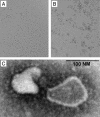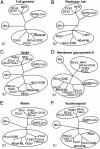A previously undescribed coronavirus associated with respiratory disease in humans
- PMID: 15073334
- PMCID: PMC395948
- DOI: 10.1073/pnas.0400762101
A previously undescribed coronavirus associated with respiratory disease in humans
Abstract
The etiology of acute respiratory tract illnesses is sometimes unclear due to limitations of diagnostic tests or the existence of as-yet-unidentified pathogens. Here we describe the identification and characterization of a not previously recognized coronavirus obtained from an 8-mo-old boy suffering from pneumonia. This coronavirus replicated efficiently in tertiary monkey kidney cells and Vero cells, in contrast to human coronaviruses (HCoV) 229E and OC43. The entire cDNA genome sequence of the previously undescribed coronavirus was determined, revealing that it is most closely related to porcine epidemic diarrhea virus and HCoV 229E. The maximum amino acid sequence identity between ORFs of the newly discovered coronavirus and related group 1 coronaviruses ranged from 43% to 67%. Real-time RT-PCR assays were designed to test for the prevalence of the previously undescribed coronavirus in humans. Using these tests, the virus was detected in four of 139 individuals (3%) who were suffering from respiratory illness with unknown etiology. All four patients suffered from fever, runny nose, and dry cough, and all four had underlying or additional morbidity. Our data will enable the development of diagnostic tests to study the prevalence and clinical impact of this virus in humans in more detail. Moreover, it will be important to discriminate this previously undescribed coronavirus from HCoV 229E and OC43 and the severe acute respiratory syndrome coronavirus.
Figures



Similar articles
-
Coronavirus causes lower respiratory tract infections less frequently than RSV in hospitalized Norwegian children.Pediatr Infect Dis J. 2011 Apr;30(4):279-83. doi: 10.1097/INF.0b013e3181fcb159. Pediatr Infect Dis J. 2011. PMID: 21057374
-
A novel pancoronavirus RT-PCR assay: frequent detection of human coronavirus NL63 in children hospitalized with respiratory tract infections in Belgium.BMC Infect Dis. 2005 Feb 1;5:6. doi: 10.1186/1471-2334-5-6. BMC Infect Dis. 2005. PMID: 15686594 Free PMC article.
-
Clinical disease in children associated with newly described coronavirus subtypes.Pediatrics. 2007 Jan;119(1):e70-6. doi: 10.1542/peds.2006-1406. Epub 2006 Nov 27. Pediatrics. 2007. PMID: 17130280
-
Identification of new human coronaviruses.Expert Rev Anti Infect Ther. 2007 Apr;5(2):245-53. doi: 10.1586/14787210.5.2.245. Expert Rev Anti Infect Ther. 2007. PMID: 17402839 Review.
-
The widening scope of coronaviruses.Curr Opin Pediatr. 2006 Feb;18(1):42-7. doi: 10.1097/01.mop.0000192520.48411.fa. Curr Opin Pediatr. 2006. PMID: 16470161 Review.
Cited by
-
Investigation of the Effect of the COVID-19 Pandemic Period on Respiratory Tract Viruses at Istanbul Medical Faculty Hospital, Turkey.Infect Dis Rep. 2024 Oct 10;16(5):992-1004. doi: 10.3390/idr16050079. Infect Dis Rep. 2024. PMID: 39452164 Free PMC article.
-
Mechanism, structural and functional insights into nidovirus-induced double-membrane vesicles.Front Immunol. 2024 Jun 11;15:1340332. doi: 10.3389/fimmu.2024.1340332. eCollection 2024. Front Immunol. 2024. PMID: 38919631 Free PMC article. Review.
-
[Respiratory viruses: old and new. Review of diagnostic methods].Enferm Infecc Microbiol Clin. 2007 Oct;25:60-65. doi: 10.1157/13111839. Epub 2009 Jan 6. Enferm Infecc Microbiol Clin. 2007. PMID: 38620190 Free PMC article. Spanish.
-
Lys417 acts as a molecular switch that regulates the conformation of SARS-CoV-2 spike protein.Elife. 2023 Nov 22;12:e74060. doi: 10.7554/eLife.74060. Elife. 2023. PMID: 37991488 Free PMC article.
-
A resource of human coronavirus protein-coding sequences in a flexible, multipurpose Gateway Entry clone collection.G3 (Bethesda). 2023 Jul 5;13(7):jkad105. doi: 10.1093/g3journal/jkad105. G3 (Bethesda). 2023. PMID: 37267226 Free PMC article.
References
-
- Bertino, J. S. (2002) Am. J. Med. 112, 42S-49S. - PubMed
-
- Juven, T., Mertsola, J., Waris, M., Leinonen, M., Meurman, O., Roivainen, M., Eskola, J., Saikku, P. & Ruuskanen, O. (2000) Pediatr. Infect. Dis. J. 19, 293-298. - PubMed
-
- Madeley, C. R. & Field, A. M. (1988) in Virus Morphology, eds. Madeley, C. R. & Field, A. M. (Chruchill Livingstone, New York).
Publication types
MeSH terms
Substances
Associated data
- Actions
- Actions
- Actions
LinkOut - more resources
Full Text Sources
Other Literature Sources


